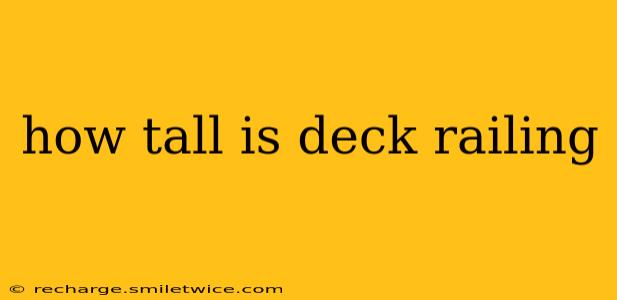Building a deck is a fantastic way to expand your living space and enjoy the outdoors. However, safety should always be the top priority, and that starts with understanding deck railing height regulations. The height of your deck railing isn't just a matter of aesthetics; it's a crucial factor in preventing falls and ensuring the safety of your family and guests. This guide will delve into the specifics of deck railing height, covering various factors and frequently asked questions.
What is the Standard Height for Deck Railing?
The standard height for deck railing in most regions of North America is 36-42 inches (91.44-106.68 cm). However, it's crucial to check your local building codes, as these regulations can vary depending on your location. These codes often specify exact height requirements and may also include provisions for specific situations, such as decks with different heights or those near pools. Never rely solely on general guidelines; always consult your local building department for precise requirements.
What are the Building Code Requirements for Deck Railing Height?
Building codes are designed to protect people, and they vary slightly depending on the region. While 36-42 inches is a common range, some areas might mandate slightly higher or lower heights depending on specific factors. Consult your local building department or a qualified building inspector for exact requirements in your area. These professionals can provide detailed information specific to your location and the specifics of your deck construction. Ignoring building codes can lead to fines and, more importantly, compromise the safety of those using your deck.
Why is the Height Range 36-42 inches?
The range accommodates various design preferences while still ensuring adequate safety. A height below 36 inches might not provide sufficient protection against falls, particularly for children or adults who might lean or trip. On the other hand, a height significantly above 42 inches can present challenges for accessibility and usability.
What is the Minimum Height for Deck Railing?
While the standard range is 36-42 inches, the minimum height rarely falls below 36 inches (91.44 cm). Anything less than this is generally considered insufficient to meet safety standards and may not be approved by building inspectors. It's always best to err on the side of caution and comply with the upper end of the recommended range or exceed it if possible.
Are There Different Railing Height Requirements for Different Deck Heights?
This often depends on local codes. Some jurisdictions may have specific regulations concerning varying deck heights, especially when a significant drop-off is involved. For elevated decks, higher railings might be required. Again, always refer to your local building codes for accurate information on this matter.
What About Balusters and Spacing?
In addition to the overall railing height, building codes also specify requirements for balusters (vertical spindles) and the spacing between them. These regulations help prevent children or small objects from falling through the gaps. Typical spacing requirements range from 4 inches maximum. Ensure your balusters meet these requirements to adhere to safety standards.
What Happens if My Deck Railing is Too Short?
Having a deck railing that doesn't meet code can result in several problems. The most serious consequence is the risk of injury or death due to falls. Beyond personal safety, failing to meet code can result in fines, delays in obtaining permits, and potentially issues with homeowner's insurance if an accident occurs. If your railing is too short, you'll likely need to correct the issue before any further use of the deck is allowed.
Conclusion: Prioritize Safety
Building a deck is a significant investment. Prioritizing safety from the outset is crucial, and choosing the correct railing height is a key element in achieving this goal. Always consult local building codes and work with experienced professionals to ensure your deck meets all safety regulations. The peace of mind gained from knowing your deck is safe is invaluable. Remember, building codes are not suggestions; they are legally mandated requirements designed to protect lives.
